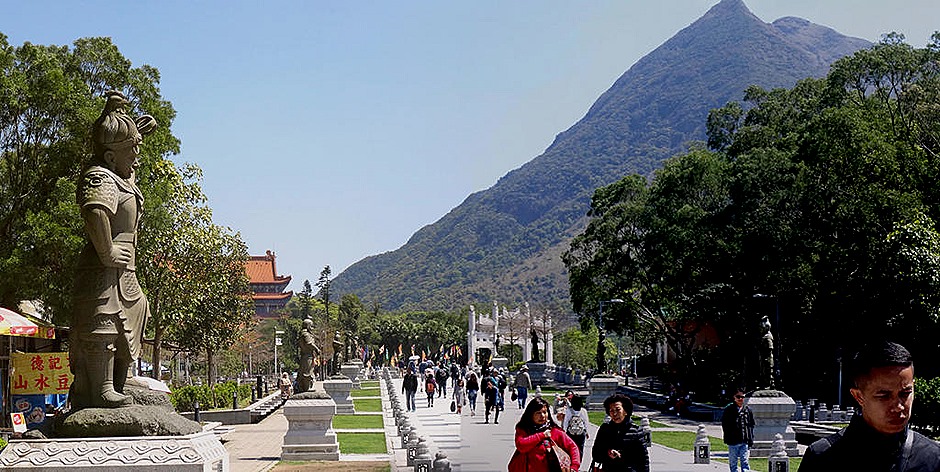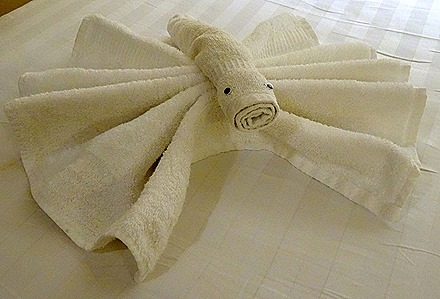Hong Kong, China (Day 2)
On March 9 we were scheduled to go on a HAL excursion to Lantau Island In the New Territories, a part of Hong Kong that is somewhat closer to mainland China. So, after the long trek through the cruise terminal, we boarded the bus & set out.
Our first stop was rather useless. It seems that about 10 years ago China completed the Tsing Ma Bridge, one of the longest suspension bridges in the world, between Hong Kong & Lantau. Before crossing the bridge we stopped at a sort of park that was built as a visitor’s center for the bridge. Why would you want to go to a viewing station for a bridge? That’s a good question, to which we never got a reasonable answer.
We saw some nice flowers in Hong Kong & many of them were in this park. So here is a selection.
So we crossed the bridge and entered Lantau Island. After the crowded skyscrapers of Hong Kong it is rather a surprise that Lantau has so much undeveloped green area. And to keep it that way they have instituted strict environmental regulations. Most notably for us, only vehicles certified as meeting Lantau’s environmental standards are permitted to drive there. This meant that shortly after entering the island we had to stop and change to a bus that satisfies the regulations. They have begun work on a tunnel under the bay between Kowloon & Lantau, which is expected to make travel there much easier. Lantau was pretty much a backwater until the new airport was built there in 1998 (the old one was where our ship docked this year). Today it also houses the Hong Kong Disneyland, in addition to the attractions we visited while there.
Our first stop was to visit Tai O village, one of the oldest fishing villages in Hong Kong. It was once the center of Lantau’s thriving salt trade with mainland China. Today it is a regular stop for visitors to Lantau but still engages in fishing and has several good seafood restaurants. It is situated on both sides of a channel between Lantau and a smaller island; once you had to cross on a boat but today there is a bridge.
After crossing the bridge onto the island side you come shortly to what our guide told us is the Kwan Ti temple. Built around 1500, it is dedicated to the god of war. Next to it is a tiny temple dedicated to the god of sailing that looks just as old.
The roof of the Kwan Ti temple is lined with what looks like colored ceramic figures of beasts, including a lion and a bird that may be a goose, along with a number of people who may represent former residents of the town. They are looking very good if they have been outside on the top of a building for 500 years of squalls and typhoons.
We spent some time walking up and down the streets of the village. There were a number of shops open to the street (lots of tourists come here), including several food shops, some with blowfish hanging from the awning & some with live fish that can be purchased and carried to a restaurant for preparation.
Leaving Tai O we drove to the Tian Tan Buddha, a massive structure known colloquially as the Big Buddha. It is cast in bronze and is well over 100 feet high and weighs about 250 tons. Until recently it was the largest seated bronze Buddha in the world but our guide told us that a bigger one was opened recently. We were expecting to be able to walk up the 268 steps to the Buddha, sitting on a bed of lotus petals, but apparently we were behind schedule since they drove us to the top instead. On the walkway below the Buddha are large bronze sculptures of three maidens making offerings to him.
The Buddha is on top of a mountain, so there are some great views from there, including one of the Lin Po Monastery below, where we had lunch.
We drove down in the bus (boo) & walked along a promenade lined with statues of old Chinese generals toward the Monastery. We did not get to tour it, but we did eat a very good vegetarian Chinese lunch at a restaurant in the Monastery.
After lunch we walked back up the promenade to a commercial area of restaurants (Starbucks) & souvenir shops called Ngong Ping Village. Its not really a village at all, but it is the terminus for the cable car to Tung Chung, the town near the airport. We climbed in the gondola, which is suspended from a cable very high in the air. It took about half an hour to go over the top of a mountain and down to Tung Chung. As we left we had a nice view of the Big Buddha sitting on top of its mountain and as we neared the end we had a gut-wrenching but beautiful view of the airport far beneath us. One woman in our gondola kept her eyes shut the whole time!
We transferred to the bus at Tung Chung and drove back to the cruise port. On the way we passed a tall building under construction covered in bamboo scaffolding, which is common here (take a closer look at the scaffolding in the first Tai O picture), as is wash hanging from the balconies of high rise residential buildings. Our guide told us that because electricity is quite expensive in Hong Kong people wash their clothes in machines but hang them outside to dry for free.
We sailed away at sunset and passed a stilted village on the other side of the harbor. After dinner we went to bed as the ship sailed south toward Vietnam.





























































I climbed the 268 steps in 2005 when I was much younger, then I climbed down. We also ate at the same restaurant. We were not sure we would like the food, so we packed a lunch from the ship but did enjoy the meal. Last time I was there we went to Disney Land. That is why going back to the same place you can do different things.
July 25, 2018 at 6:31 pm
I am enjoying your trip very much, thanks for keepi9ng this photojournalist
July 26, 2018 at 8:58 am